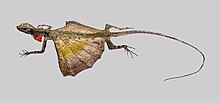Draco volans
| Draco volans | |
|---|---|

| |
| Scientific classification | |
| Domain: | Eukaryota |
| Kingdom: | Animalia |
| Phylum: | Chordata |
| Class: | Reptilia |
| Order: | Squamata |
| Suborder: | Iguania |
| Family: | Agamidae |
| Genus: | Draco |
| Species: | D. volans
|
| Binomial name | |
| Draco volans | |

Draco volans, also commonly known as the common flying dragon, is a species of lizard in the family Agamidae.[2][3] The species is endemic to Southeast Asia.[2] Like other members of genus Draco, this species has the ability to glide using winglike lateral extensions of skin called patagia.[4]
The species is exclusively arboreal.[5]
Description
[edit]D. volans grows to a length of up to 22 cm (8.7 in), including the tail. The body is tan in colour with dark flecks.[6]
The patagium of the male is tan to bright orange with dark banding. The female's patagium has irregular markings rather than banding.[6]
Habitat
[edit]D. volans can be found in tropical rainforests in Southeast Asia.[3] It is commonly found in early second growth forests, in open secondary forest, and on forest edges.[5]
Locomotion
[edit]The "wings" of D. volans are supported by its ribs, which form the skeleton of the patagia. However, its elongated ribs are superadded to aid forming its "wings", and not to assist respiration.[7]
This species is considered a passive glider, or parachutist.[8] However, previous studies have also shown that it can be considered a gliding animal.[9] This means that it does not have to deal with the aerodynamic and metabolic imperatives required for active flight.[10]
Behaviour
[edit]D. volans is diurnal, and is "commonly seen running along branches, displaying, and gliding".[5]
Courtship
[edit]The colouration of the patagia and the dewlap play key roles in the courtship of D. volans, with the males stretching out and displaying their patagia and dewlaps to get the attention of the females.[4]
Diet
[edit]Draco volans feeds mainly on ants, and possibly other insects like termites.[6][3] A study was conducted in Eastern Mindanao, Philippines, which found that the species exclusively feeds on ants.[5] It hunts by waiting near a tree trunk until ants come out and crawl close to its visual field; it grabs its prey without moving itself.[3]
Reproduction
[edit]The female common flying dragon digs a hole in the soil to serve as a nest, and lays eggs in it.[4]
References
[edit]- ^ Quah, E.; Grismer, L.; McGuire, J. (2018). "Draco volans ". IUCN Red List of Threatened Species. 2018: e.T99929352A99929358. doi:10.2305/IUCN.UK.2018-2.RLTS.T99929352A99929358.en. Retrieved 18 November 2021.
- ^ a b Species Draco volans at The Reptile Database www.reptile-database.org.
- ^ a b c d Van Arsdale, Michael (1999). "Draco volans ". Animal Diversity Web.
- ^ a b c Crew, Bec (29 May 2014). "Flying dragon lizard a true gliding reptile". Australian Geographic.
- ^ a b c d Smith, Brian E. (December 1993). "Notes on a Collection of Squamate Reptiles from Eastern Mindanao, Philippine Islands Part 1: Lacertilia" (PDF). Asiatic Herpetological Research. 5: 85–95.
- ^ a b c Baker, Nick. "Draco volans ". EcologyAsia.
- ^ Home, Everard (1812). "Observations Intended to Show That the Progressive Motion of Snakes is Partly Performed by means of the Ribs". Philosophical Transactions of the Royal Society of London. 102: 163–168. doi:10.1098/rstl.1812.0011. JSTOR 107313.
- ^ Maina, John N. (11 July 2006). "Development, structure, and function of a novel respiratory organ, the lung-air sac system of birds: to go where no other vertebrate has gone". Biological Reviews. 81 (4): 545–579. doi:10.1111/j.1469-185X.2006.tb00218.x. PMID 17038201. S2CID 221532705.
- ^ Colbert, Edwin H. (10 March 1967). "Adaptations for Gliding in the Lizard Draco " (PDF). American Museum Novitates (2283): 1–20.
- ^ Maina, John N. (3 July 2015). "The design of the avian respiratory system: development, morphology and function". Journal of Ornithology. 156: 41–63. doi:10.1007/s10336-015-1263-9. S2CID 15768990.
Further reading
[edit]- Boulenger GA (1885). Catalogue of the Lizards in the British Museum (Natural History). Second Edition. Volume I. Geckonidæ, Eublepharidæ, Uroplatidæ, Pygopodidæ, Agamidaæ. London: Trustees of the British Museum (Natural History). (Taylor and Francis, printers). xii + 436 pp. + Plates I–XXXII. (Draco volans, p. 256).
- Cox MJ, van Dijk PP, Nabhitabhata J, Thirakhupt K (1998). A Photographic Guide to Snakes and other Reptiles of Peninsular Malaysia, Singapore and Thailand. Sanibel Island, Florida: Ralph Curtis Books. 144 pp. ISBN 978-0883590430. (Draco volans, p. 101).
- Linnaeus C (1758). Systema naturæ per regna tria naturæ, secundum classes, ordines, genera, species, cum characteribus, differentiis, synonymis, locis. Tomus I. Editio Decima, Reformata. Stockholm: L. Salvius. 824 pp. (Draco volans, new species, pp. 199–200). (in Latin).

